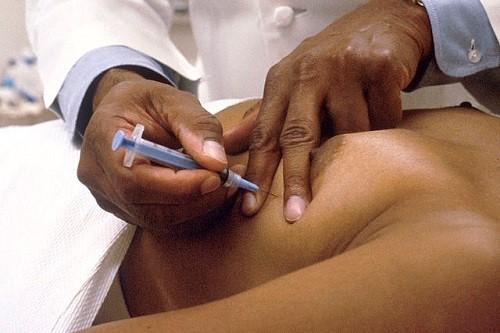Fine-needle aspiration
Peer reviewed by Dr Hannah Gronow, MBACPLast updated by Dr Roger Henderson, MBBSLast updated 22 Nov 2018
Meets Patient’s editorial guidelines
- DownloadDownload
- Share
This page has been archived.
It has not been reviewed recently and is not up to date. External links and references may no longer work.
In fine-needle aspiration a thin, hollow needle is used to take a sample of cells from an organ or lump under the skin. The cells are then analysed under a microscope.
Note: the information below is a general guide only. The arrangements and the way tests are performed, may vary between different hospitals. Always follow the instructions given by your doctor or local hospital.
In this article:
Continue reading below
What is fine-needle aspiration?
Fine-needle aspiration involves using a thin, hollow needle to remove samples of cells from tissue or fluid in an organ or a lump. It is not quite the same as a biopsy, which takes a very small chunk of tissue away. Once the samples of cells have been removed, they are sent to the laboratory for further testing.
Fine-needle aspiration is usually done to identify the type of cells inside a lump or to see how well treatment of an existing lump is working.
It is commonly used to investigate lumps found in the breast or a gland found in your neck (the thyroid). However, it can also be used in other parts of the body. It is a very useful way of detecting cancer.
How does fine-needle aspiration work?
A very thin, hollow needle is gently inserted through the skin into the lump or organ below. Often there is a syringe attached to the needle. The doctor can use the syringe to help 'suck' some of the cells into the needle by gently pulling on the plunger.
Usually, the test can be done without the need to make a cut in the skin. This helps to minimise any discomfort for the person having the test, as well as the risk of infection or other complications.
If the lump being tested is very small it might be necessary to use a scanning machine to help guide the needle to the right place. This may be done by an ultrasound scan, a computerised tomography (CT) scan or an X-ray of the breast (a mammogram).
Continue reading below
What happens?
The doctor will clean the skin where the needle is to be inserted. In some cases you will also be given a local anaesthetic to numb the area. This may not be necessary if the lump is very close to the surface of your skin.
The doctor will hold the lump steady with one hand and insert a thin needle (which may be attached to a syringe) into the lump.
Fine-needle aspiration

By Linda Bartlett (photographer), National Institutes of Health, via Wikimedia Commons
They may move the needle in and out of the area to make sure of getting enough tissue or fluid. If there is a syringe attached they will gently pull back on the plunger to help remove the tissue or fluid. The process takes a few seconds to a few minutes. The needle will then gently be removed and your doctor may apply some pressure to help stop any bleeding.
If the doctor cannot easily feel the lump, you may have an imaging test, such as a CT scan, ultrasound scan, or mammogram to see where to put the needle. In this case, a doctor known as a radiologist may do the aspiration. The radiologist may do the investigation but they will not know the result immediately.
If the lump is a fluid-filled sac (a cyst), the fluid is removed and the lump usually goes away.
After the test is over, the cells taken from the needle are sent to the laboratory. It may take a few days to get the results of the test back, depending on what part of your body has been tested.
What should I do to prepare for a fine-needle aspiration?
This depends on what part of your body is being tested. Your local hospital should give you information on what is required. Usually very little preparation is necessary.
Note: if you take a blood-thinning medicine (an anticoagulant) such as warfarin, you may be asked to stop taking this for a few days before the procedure.
Continue reading below
What can happen after a fine-needle aspiration?
Most fine-needle aspirations are carried out without any problems.
Commonly, you may feel a little sore for a couple of days after the test. You may develop a bruise at the site where the needle was inserted. Complications are uncommon but can include:
Bleeding or bruising. This should stop and heal quickly.
Infection at the point where the needle went in.
Other complications specific to the site of needle insertion.
Further reading and references
- Karadeniz Cakmak G, Emre AU, Tascilar O, et al; Diagnostic adequacy of surgeon-performed ultrasound-guided fine needle aspiration biopsy of thyroid nodules. J Surg Oncol. 2012 Jul 5. doi: 10.1002/jso.23212.
- Yu YH, Wei W, Liu JL; Diagnostic value of fine-needle aspiration biopsy for breast mass: a systematic review and meta-analysis. BMC Cancer. 2012 Jan 25;12:41.
- VanderLaan PA; Fine-needle aspiration and core needle biopsy: An update on 2 common minimally invasive tissue sampling modalities. Cancer Cytopathol. 2016 Dec;124(12):862-870. doi: 10.1002/cncy.21742. Epub 2016 May 16.
Article history
The information on this page is written and peer reviewed by qualified clinicians.
22 Nov 2018 | Latest version

Ask, share, connect.
Browse discussions, ask questions, and share experiences across hundreds of health topics.

Feeling unwell?
Assess your symptoms online for free